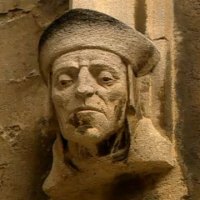Justinian I
Byzantium
Britain AD: King Arthur’s Britain
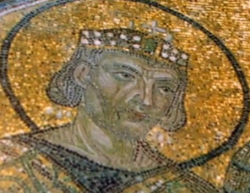
Justinian I
Dr Ken Dark “In the sixth century the Byzantine emperor Justinian I organised an attempt to reconquer the Western Roman Empire. This program of
reconquest was accompanied by a diplomatic initiative, the charm offensive to try to get local elites across Western Europe on board. One area where
such elites existed was in Western Britain. And it’s possible that what we see as trade between the Byzantine world and the British West was, in
fact, diplomacy between Constantinople and the British kings who ruled that area.”
Whether or not these traders are on a political mission, I am certain that this contact was never purely commercial.
Trade networks established between Britain and Byzantium provided a basis for the transmission of spiritual and intellectual ideas.
Charles Thomas “They are bringing with them a whole range of new ideas. Archaeology can sure start. Archaeology, history and language between
them can infer its existence and the dirt archaeology of pots shows just one method by which it could have come. So, yes, there is a trade in ideas.”

Dr Ken Dark
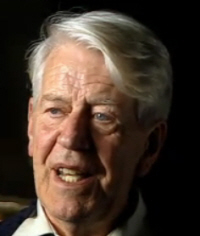
Charles Thomas
The Byzantine merchants did not sail half across the known world to visit a deteriorating island. They came to an economically independent country
whose people had goods and ideas to share with the rest of the world. But what were these ideas? There was one more step in the pottery story that
would reveal the words of a dark age civilisation hidden for centuries.
Very little written material survives from the fifth and sixth centuries in Britain. For a long time, this was taken as proof that these were
illiterate, uneducated times.
In actual fact, nothing could be further from the truth. Dark Age Britain was a time of intellectual and economic advance. A single shard of
Mediterranean pottery, identical to Tintagel material, was recently found on the remote island of Caldey, off the south coast of Wales.
Caldey has been a holy island for hundreds of years. It still houses a monastery today. Jonathan Wooding showed me around.
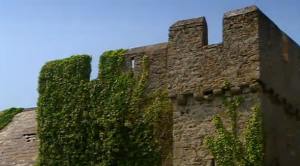
Caldey Monastery
Dr Jonathan Wooding “it’s the only piece found here, but there’s doubtless got to be more. Pieces of ceramics, where they’re turning up,
represent a period when the East is interested in the West. It’s sending trade or diplomatic missions, whatever it may be, but eastern people
are turning up in Celtic Britain and there expecting to find people who are essentially like them, descendants of Romans, who know the same
languages, the same rituals, the same basic cultural ideas.”
Caldey was part of the early monastic movement which arrived in Britain, with the pottery, on boats from the Mediterranean.
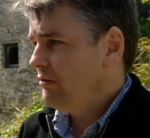
Jonathan Wooding
Jonathan Wooding “The monastic movement arrives at the same time as the end of Roman rule. In the East, it was already playing a part in
providing a new focus of leadership in a changing society. I’m sure it was much the same here. People took it up with great enthusiasm as an
alternative to the more settled or urban Christianity of the Roman world.”
Dozens of monasteries sprang up in Britain in the Dark Age period, and they produced a new class of learned monk. There is one historical source
for Dark Age Britain, written by a monk named Gildas in the sixth century about 100 years after the departure of the Romans. It’s an extraordinary,
arousing account of this country’s history. It was written in high-grade and rather flowery Latin. It was meant for a sophisticated audience, as
it’s peppered with classical references.
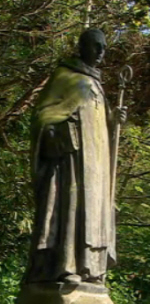
Gildas
Jonathan Wooding “Gildas was his era’s pre-eminent theologian of monasticism. The great founder of Irish monasteries on the continent, actually,
cites him to the Pope as someone he ought to have read, Gregory the Great, the most monastic Pope of the first millennium. He is very much a figure who
is known all over Western Europe. A world that can produce a Gildas is a learned world in close connection with the wilder intellectual, a wilder
religious community. He certainly isn’t a unique figure. He is unique in perhaps our records, but it tells you more about our records than about
the time.”
Gildas and others were not isolated monks hidden away from reality, but scholars in touch with the intellectual and religious ideas of their time.
Jonathan Wooding “We see a Britain that’s in contact with the rest of the world. It’s not just an eastern missionary turning up in an odd
place. Will have to think about it now as a much more global thing. The scale of finds at Tintagel and Bantham make it unlikely there’s just
one or two ships. But more finds are turning up every year, and in time, we will have a much clearer picture of the scale of these contacts.
They’re more or less contacts that escaped history, so archaeology has really told you something that you just simply didn’t know before.”
Literacy was not confined to the monastic elite in dark age Britain. Caldey Island had one more secret to give up in the form of an ancient
stone inscribed in Latin.
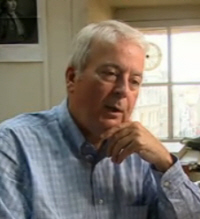
Dr David Howlett
Dr David Howlett “With the sign of the cross, I ask from all those walking there that they pray for the soul from within of Cadogan. This is
rhythmic, syllabic, Adonic verse, and it is by centuries of the oldest. These people are using the metres that become the standard fare of all
subsequent European literature. It is not Dark Age. It is not illiterate.”
Stones like the one in Caldey have been found scattered across western Britain. These inscribed stones provide clear evidence for a highly
literate society in Dark Age Britain. They are memorials, written not by kings or priests, but by ordinary people committing their thoughts
to stone.
For centuries, these inscriptions have been dismissed as the clumsy scrawling of a semi-literate society. In actual fact, they give us unique
insight into the ideas that were structuring early British thought.
The job of deciphering these ancient messages has been the work of David Howlett, editor of the Latin mediaeval dictionary in Oxford.
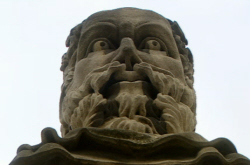
Stone Embodimnt
David Howlett “We’re coming into the oldest part of the Bodleian library, and what we see here is an embodiment in stone of the view of the
universe that our ancestors had adopted from antiquity. Seven liberal arts. The human constructs of language, grammar, rhetoric and logic. The
divine hard science, all of them mathematical. Arithmetic static number, music is moving number, astronomy, geometry.”
David believes that the structures which still shape learning today were first formulated in the Dark Ages. Was it intellectual opposition that
structured the way they thought?
David Howlett “It was a cooperation, a combination. You have the school of languages at the same door as the school of geometry and arithmetic.
And over there, the school of astronomy in the same door as the school of rhetoric. It was a cooperation, a combination, the human arts with divine
mathematical art. You need both. You cannot have one without the other. During the six century, modern Europe is invented, and its invented here.
Inide Britain, what we have is both this highly polished, rhetorical Latinity from Gildas, 130 years after the departure of the legions, and these
stone inscriptions. Now the inscriptions have looked like ropey, odd Latin prose, because they are in fact verse. Nobody read them aloud to see
that they go ‘dumpty, dumpty, dumpty’. It’s just there, you see it. And once you see it it transforms your view of what you are reading and, even
more, your view of the society from which this emerged.”
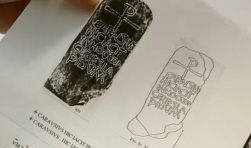
Stone Inscriptions
Some of these stone inscriptions contain hidden layers of meaning.
David Howlett “The inscription reads ‘Carausius hic iacit in hoc congeries lapidum’, ‘Caurasias here lies in this’. A heap of stones.
Straightforward. But if you read it back words, it reads ‘um lapid es geri con hoc in lacit hic ius aus car’ – which is a faultless
dactylic hexameter.”
That’s classical Latin.
David Howlett “This is classical Latin, poetry, but read backwards. If we return to the straightforward Carausius inscription and count at
intervals of seven letters, we find the name of the woman who designed this, which is Viola. Yorvert and Rallaund in sepulchres look in peace for
the awesome advent of the judgement. O sanctissima mulier hic lacit. Que fuit amatissima coniux Biva Tisi. Au diva. A most holy woman here lies
who was the most beloved wife of Biva Tisus. In morals, discipline and for wisdom than gold and precious stones, this woman was better. Now,
she is the most holy, most beloved wife of a bishop.”
You’ve said that there are thousands of these dark age inscriptions. That does rather imply that there were awful lot of readers. Some of
these inscriptions are on hillsides in deepest Brahaneum. The imply that there is a large class, large enough numbers to make this worthwhile.
David Howlett “These islands are the focus for the real survival of Latin. If you imagine that at the time of the departure of the legions, the
Brits are the only people in Europe who carry on writing very literary Latin. This stayed pure, as they were the only people in Europe who did not
speak a Romance mother tongue. There was less linguistic interference from one to the other, so they learned Latin by the book. Rather like Salman
Rushdie learning English by the book and then writing very high-level literary language. The Brits are the only ones in Europe who do this.”
Are we looking at a Renaissance?
David Howlett “For a renaissance to occur, you have to have a dark age, and I don’t think the dark age ever existed. What I see is continuity
in the intellectual life. The fall of Rome in 410, what caused the withdrawal of the legions from Britain, is a finite historical moment with great
ramifications, they are serious and catastrophic. People have just supposed that that was what happened in Roman Britain, but it didn’t. This is
the only place that did not happen.”
So instead of actually turning the lights out, do you actually think that the lights were turned up brighter.
David Howlett “This is the only place in which they were.”









